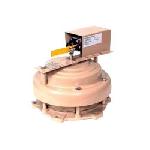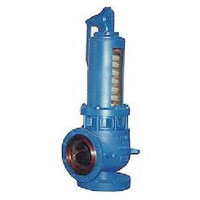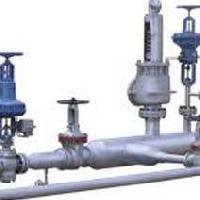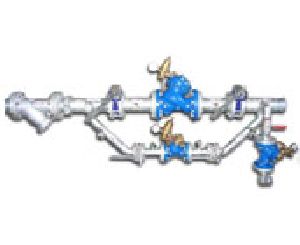






PRV 300 Pressure Reducing Valve
Get Price Quote
1 Piece (MOQ)
Steam Theory1. Basics of Steam2. Steam Heating3. Basics of Steam Traps4. Steam Trap Selection5. Steam Trap Problems6. Steam Trap Management7. Water Hammer8. Risk Mitigation9. Steam Quality10. Steam Distribution11. Condensate Recovery12. Energy Efficiency13. Compressed Air / Gas14. Other ValvesTypes of Manual ValvesBypass ValvesCheck Valve Installation and BenefitsPressure Reducing Valves for SteamPressure Reducing Valves for SteamContents:Reducing Steam PressureAdvantages of Pressure Reducing ValvesTypes of Pressure Reducing Valves for SteamDirect Acting (Non-piloted)Pilot-OperatedSummaryIn a steam-using plant, steam is often generated at high pressures and reduced locally to provide heat for each steam user. This is usually done to minimize the diameter of steam distribution piping and enable more cost-efficient steam delivery. Reducing Steam PressureA common way of lowering pressure is by throttling down the size of the steam passageway. For the most basic pressure reduction, it is possible to simply use a conventional globe valve in a fixed partly-open position, or by inserting an orifice plate into the flow of steam. However, any fluctuation in flow rate would be accompanied by a corresponding fluctuation in pressure. To avoid such circumstances, pressure reducing valves (PRVs) can be used to provide precise control of downstream pressure. They automatically adjust the amount of valve opening to allow the pressure to remain unchanged even when the flow rate fluctuates. Advantages of Pressure Reducing ValvesWhile it is possible to maintain a constant pressure by using the combination of an actuated control valve, a pressure sensor, and a controller, a pressure reducing valve offers the advantage of being able to control pressure through fully-automatic self-contained operation, requiring no type of external power source. It can offer the further advantage of extremely rapid response action by immediately sensing and adjusting based on the downstream pressure. Reducing Steam Pressure Fig. 1 Heating processes usually benefit from using steam at a lower pressure than that supplied by the boiler. Thus, pressure reducing valves are often used to reduce steam pressure to the set point value required by the process. Types of Pressure Reducing Valves for SteamIn pressure reducing valves, the mechanism that automatically adjusts the downstream pressure typically uses the balance of forces between the steam pressure and an adjustment spring. At present, this is a universal concept on almost all manufactured pressure reducing valves. However, there are two different ways in which this mechanism is implemented to control the amount of valve opening: Non-piloted, Direct Acting Valve: Adjustment spring places downward pressure setting force directly on the main valve.Pilot-Operated Valve: Adjustment spring places downward pressure setting force directly on a pilot valve, which is smaller and different from the main valve.The following is an overview of the features of each type of PRV. Direct Acting (Non-piloted)Used for small loads where extremely close pressure control is not needed. Pros: Compact size, low price, easy to install.Cons: Higher droop (variation from set pressure) than Pilot-operated PRV.Direct Acting Pressure Reducing Valve Pressure Reducing Valves for SteamFig. 2 Delivered steam pressure is regulated by balancing forces acting directly on the valve itself: the downward force caused by compression of the adjustment spring against the upward force from the secondary pressure acting against the underside of a bellows or diaphragm. Note: The movements in the animation are slowed and exaggerated in order to show the opening and closing of the valve. In direct acting pressure reducing valves, the amount of valve opening is determined directly by the movement of the adjustment spring. If the spring is compressed, it creates an opening force on the valve which increases flow. As pressure builds downstream, equalizing occurs by feeding the downstream pressure to the underside of the adjustment spring (usually against a bellows or diaphragm) where its upward force counter-balances against the spring compression. Spring compressive force which opens the valve is limited to allow sufficient spring sensitivity to equalize with downstream pressure changes. The net result is simple pressure control through a valve orifice where high flow rates can cause pressure droop. Pilot-OperatedUsed for larger loads where close pressure control is required Pros: Close pressure control, fast response to load variation, may be used across a broader range of flow rates than the direct acting types.Cons: Larger size, higher price.Pilot-Operated Pressure Reducing Valve Pressure Reducing Valves for SteamFig. 3 Delivered steam pressure is regulated in a similar manner as direct acting PRVs, however indirectly via a pilot valve. As the pilot valve is actuated, it provides the opening flow to the larger main valve which can supply significantly higher flow rates than the pilot itself. The pilot valve is then equalized by the secondary pressure, which correspondingly controls the opening flow to the main valve. Note: The movements in the animation are slowed and exaggerated in order to show the opening and closing of the valve. In pilot-operated pressure reducing valves, a pilot valve is used to load a piston or diaphragm that increases the downward force used to open a larger main valve. This enables larger flow capacity with a lower pressure offset (droop). The opening and closing of the pilot valve is controlled by the balance of force between the adjustment spring and the secondary pressure in the same manner that a direct-acting valve operates. However, in a pilot-operated PRV, this opening and closing of the pilot valve purposely delivers pressure to the main valve piston or diaphragm. This pilot flow pressure then causes a downward force that is amplified by the area of the piston or diaphragm to enable opening of a much larger main valve, which in turn provides the ability for very high flow rates. Because the downward force is amplified through the use of a piston or diaphragm, a small change in the opening on the pilot valve can result in a large change in flow and downstream pressure through the main valve. As a result, there is little change needed in adjustment spring force on the pilot to accomplish quick response over a wide range of steam flow rates. Quick response and tight delivered pressure control represent the main advantages of this type of valve over the direct-acting type.

Pressure Reducing Valves
Get Price Quote
Standard l/2"to 4" Meet requirements of ASSE Standard 1003.(ANST 112.26) CSA Standard 8356 ( ASSE American Society of Sanitary Engineering) (C$A Canadian Standard Assodation) Pressure / Temperature Temperature - 80oC'( For Water ) Temperature - 180oC ( For Steam) Maximum Working Pressure - 21kg&/cm2,Inlet
Best Deals from Pressure Reducing Valve

Pressure Reducing Valve
2,255 Per Piece
1 Piece (MOQ)

Pressure Reducing Valve
Get Price Quote
1 Piece (MOQ)

Pressure Reducing Valve
Get Price Quote
Size : 1⁄2” to 4” Body : ASTM A351 Gr. CF8/ CF8M/ CF3M Seat : Buna-N (Water)/ PTFE (Steam) Diaphragm : Buna-N (Water)/ PTFE (Steam) O-Ring : Buna – N Spring : Spring steel Adjusting stem : SS 304 End Connection : Screwed / Flanged Pressure Range : 10 – 35 PSI (Low Level) Temperature Range : 80°C (for Water), 180°C (for Steam) : Max Inlet 40 Kg/cm2, Outlet 12 – 25Kg/cm2, 20 – 35Kg/cm2

Pressure Reducing Valve
Get Price Quote
Self Acting, Pilot & Piston operated Reducing Valves are more Pressure Reduction of STEAM in all types of industries. The Valve Spring Balance principal. The Downstream Pressure is Sense Diaphragm Which is balanced by the Spring Tension. Increasing sp... Increases Outlet Pressure and Vice Versa.

Direct Pressure Reducing Valve Stainless Steel
Get Price Quote
Jameel Trading Company provides wide range of Direct Pressure Reducing Valve Stainless Steel, these type of valves are prefered by clients for its durability and long lasting life.

Pressure Reducing Valve
Get Price Quote
The Pressure Reducing valve reduces the pressure of the water that goes through it, and is used to obtain a regulated and constant value at its outlet. It is installed at the water mains. It protects the whole installation from problems due to excess pressure. The pressure reducing valves are completely automatic. The Pressure reducing valve is mainly used in the application where a controlled pressure is required at its output. We offer a wide range of PRV at different pressure ratings and features.

Pressure Reducing Valve & Pressure Reducing Station
Get Price Quote
Pressure Reducing Valve & Pressure Reducing Station Self Acting, Pilot & Piston operated Reducing Valves are more Pressure Reduction of STEAM in all types of industries. The Valve Spring Balance principal. The Downstream Pressure is Sense Diaphragm Which is balanced by the Spring Tension. Increasing sp... Increases Outlet Pressure and Vice Versa.

Pressure Reducing Valve
Get Price Quote
Theses valves are used for the purpose of reducing the downstream pressure and are used for steam, oil, air and other gases Flanges drilled according to BS 10 Table H or J. Can be supplied with other flanges against order. Can be supplied IBR Certificate in Form III-C.

Pressure Reducing Valve
2,350 Per Piece

Drum Type Pressure Reducing Valve
Get Price Quote
Drum Type Pressure Reducing Valve, lubrication fittings

Pressure Reducing Valve
Get Price Quote
Pressure Reducing Valve, Casting Ball Valve, Fabricated Right Angle Valve

Pressure Reducing Valve
Get Price Quote
Pressure Reducing Valve, electrical actuators, Pneumatic Gate Valve

Pressure Reducing Valve
Get Price Quote
Pressure Reducing Valve, Safety Relief Valves, Gate Valve Castings

Pressure Reducing Valves
Get Price Quote
Pressure Reducing Valves, Temperature Indicators, Temperature Sensors

Pressure Reducing Valves
Get Price Quote
Pressure Reducing Valves, Control Valves, Single Seated Globe Valves

Pressure Reducing Valves
Get Price Quote
Pressure Reducing Valves, Basket Strainer, Y Type Strainers